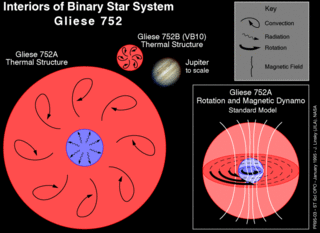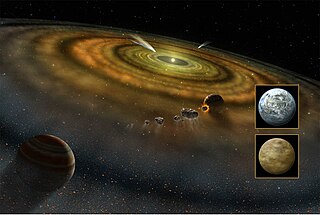4 Andromedae, abbreviated 4 And, is a single star in the northern constellation of Andromeda. 4 Andromedae is the Flamsteed designation. It is dimly visible to the naked eye with an apparent visual magnitude of 5.308. Based upon an annual parallax shift of 9.7 mas as seen from Earth's orbit, it is located 337 light years away. The star is moving closer with a heliocentric radial velocity of −11 km/s. It has a magnitude 11.7 visual companion at an angular separation of 51.10″ along a position angle of 348°, as of 2002.
77 Aquarii is a single star located 135 light years away from the Sun in the equatorial constellation of Aquarius. 77 Aquarii is its Flamsteed designation. It is visible to the naked eye as a dim star with a baseline apparent visual magnitude of 5.55. The star is moving closer to the Earth with a heliocentric radial velocity of −35 km/s.
HD 89744 is a star in the northern circumpolar constellation of Ursa Major, positioned about 0.4° due south of the bright star Tania Australis. This object has a yellow-white hue and is dimly visible to the naked eye with an apparent visual magnitude of 5.73. The distance to this star has been measured using the patallax method, which locates it 126 light years from the Sun. It is drifting closer with a radial velocity of −4.4 km/s. There are two known exoplanets orbiting this star.
HD 69863 is a binary star system in the southern constellation of Carina. It is visible to the naked eye as a dim point of light with a combined apparent visual magnitude of 5.16. The system is located at a distance of about255 light years from the Sun based on parallax. The dual nature of this system was announced in 1832 by German astronomer Carl Rümker. As of 2015, the pair had an angular separation of 4.10″ along a position angle of 70°.
42 Cassiopeiae is a possible binary star system in the northern circumpolar constellation of Cassiopeia. It is visible to the naked eye as a dim, blue-white hued star with a baseline apparent visual magnitude of +5.18. The system is located approximately 291 light years from the Sun based on parallax, and is drifting further away with a radial velocity of +7 km/s.
N Centauri is a binary star in the southern constellation of Centaurus. The brighter star is dimly visible to the naked eye with an apparent visual magnitude of 5.26, and it is approximately 304 light years away based on parallax. It has an absolute magnitude of +0.76 and is drifting further away from the Sun with a radial velocity of +27 km/s. It is a candidate member of the Sco OB2 moving group.

EQ Virginis is a single variable star in the equatorial constellation of Virgo. It has a baseline visual apparent magnitude of 9.36, but is a flare star that undergoes sporadic bursts of brightening. The star is located at a distance of 67 light-years from the Sun based on parallax measurements, but is drifting closer with a radial velocity of −23 km/s. It is a member of the IC 2391 moving group of stars, which is between 30 and 50 million years old.
LN Andromedae, also known as HD 217811, HR 8768, is a formerly suspected variable star in the constellation Andromeda. Located approximately 458 parsecs (1,490 ly) away from Earth, it shines with an apparent visual magnitude 6.41, thus it can be seen by the naked eye under very favourable conditions. Its spectral classification is B2V, meaning that it's a hot main sequence star, emitting light approximately with a blackbody spectrum at an effective temperature of 18,090 K.
Gamma Doradus, Latinized from γ Doradus, is the third-brightest star in the southern constellation of Dorado. It is faintly visible to the naked eye with an apparent visual magnitude of approximately 4.25, and is a variable star, the prototype of the class of Gamma Doradus variables. The star is located at a distance of 67 light years from the Sun based on parallax, and is drifting further away with a radial velocity of +25 km/s. Based on its motion through space, it appears to be a member of the IC 2391 supercluster.
GJ 3379 is the nearest star in the Orion constellation, located at a distance of 17 light years from the Sun based on parallax. It is a single star with an apparent visual magnitude of +11.31 and an absolute magnitude of +12.71, therefore, the star is not visible with the naked eye. It is positioned in the upper left part of the Orion constellation, to the SSE of Betelgeuse. This star is drifting further away with a radial velocity of +30.0 kilometers per second. In the past, this star had a relatively close encounter with the Solar System. Some 161,000±6,000 years ago, it achieved a minimum distance of 4.08 ± 0.20 ly (1.25 ± 0.06 pc).

Gliese 752 is a binary star system in the Aquila constellation. This system is relatively nearby, at a distance of about 19 light years. This system consists of two M-type stars. The primary star is the magnitude 9 Gliese (GJ) 752 A. The secondary star is the dim magnitude 17 Gliese (GJ) 752 B, more commonly referred to as VB 10. This stellar pair form a binary star system separated by about 74 arc seconds. This system is also known for its high proper motion of about 1 arc second a year.

25 Orionis, less commonly known by its Bayer designation Psi1 Orionis is a fifth-magnitude star in the constellation Orion. It lies among a dense cluster of low-mass pre-main-sequence stars in the Orion OB1a.
μ Cygni, Latinised as Mu Cygni, is a binary star system in the northern constellation of Cygnus. It is visible to the naked eye as a faint point of light with a combined apparent visual magnitude of 4.49. The system is located 72 light years distant from the Sun, based on parallax, and is drifting further away with a radial velocity of +17 km/s.
Nu Fornacis, Latinized from ν Fornacis, is a single, variable star in the southern constellation of Fornax. It is blue-white in hue and faintly visible to the naked eye with an apparent visual magnitude that fluctuates around 4.69. This body is located approximately 370 light years distant from the Sun based on parallax, and is drifting further away with a radial velocity of +18.5 km/s. It is a candidate member of the Pisces-Eridanus stellar stream, which suggests an age of 120 million years or less.

An exocomet, or extrasolar comet, is a comet outside the Solar System, which includes rogue comets and comets that orbit stars other than the Sun. The first exocomets were detected in 1987 around Beta Pictoris, a very young A-type main-sequence star. There are now a total of 27 stars around which exocomets have been observed or suspected.
8 Persei is a single star in the northern constellation of Perseus, located 416 light years away from the Sun. It is visible to the naked eye as a dim, orange-hued star with an apparent visual magnitude of 5.757. There is an estimated 52% chance that the star may be a member of the Hyades–Pleiades stream of co-moving stars.

Tabby's Star is an F-type main-sequence star in the constellation Cygnus approximately 1,470 light-years from Earth. Unusual light fluctuations of the star, including up to a 22% dimming in brightness, were discovered by citizen scientists as part of the Planet Hunters project. In September 2015, astronomers and citizen scientists associated with the project posted a preprint of an article describing the data and possible interpretations. The discovery was made from data collected by the Kepler space telescope, which observed changes in the brightness of distant stars to detect exoplanets.

In astronomy, a disrupted planet is a planet or exoplanet or, perhaps on a somewhat smaller scale, a planetesimal, moon, exomoon or asteroid that has been disrupted or destroyed by a nearby or passing astronomical body or object such as a star. Necroplanetology is the related study of such a process. Nonetheless, the result of such a disruption may be the production of excessive amounts of related gas, dust and debris, which may eventually surround the parent star in the form of a circumstellar disk or debris disk. As a consequence, the orbiting debris field may be an "uneven ring of dust", causing erratic light fluctuations in the apparent luminosity of the parent star, as may have been responsible for the oddly flickering light curves associated with the starlight observed from certain variable stars, such as that from Tabby's Star, RZ Piscium and WD 1145+017. Excessive amounts of infrared radiation may be detected from such stars, suggestive evidence in itself that dust and debris may be orbiting the stars.

RW Aurigae is a young binary system in the constellation of Auriga about 530 light years away, belonging to the Taurus-Auriga association of the Taurus Molecular Cloud. RW Aurigae B was discovered in 1944.
HD 72945 and HD 72946 form a co-moving star system in the northern constellation of Cancer. HD 72945 is a binary star that is dimly visible to the naked eye as a point of light with an apparent visual magnitude of 5.91. At an angular separation of 10.10″ is the fainter companion star HD 72946 at magnitude 7.25. It is being orbited by a brown dwarf. The system as a whole is located at a distance of approximately 84 light years from the Sun based on parallax measurements.









